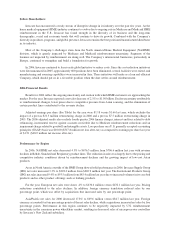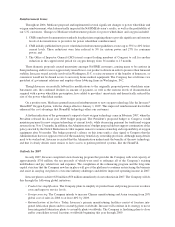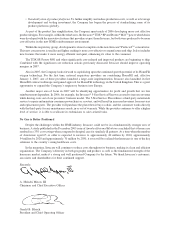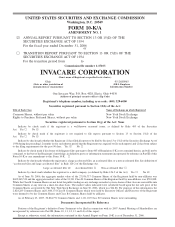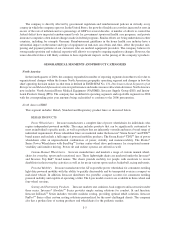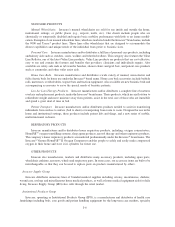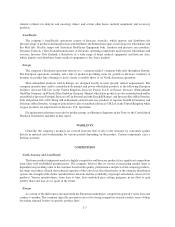Invacare 2006 Annual Report Download - page 2
Download and view the complete annual report
Please find page 2 of the 2006 Invacare annual report below. You can navigate through the pages in the report by either clicking on the pages listed below, or by using the keyword search tool below to find specific information within the annual report.Reimbursement Issues
Throughout 2006, Medicare proposed and implemented several significant changes to power wheelchair and
oxygen reimbursement, which dramatically impacted the NA/HME division’s results, as well as the profitability of
our U.S. customers. Changes to Medicare reimbursement policies for power wheelchairs and oxygen included:
1. CMS issued new documentation standards for physicians requiring them to provide significant and onerous
levels of documentation to providers for power wheelchair reimbursement;
2. CMS initially published new power wheelchair reimbursement guidelines at rates up to 35% to 40% below
current levels. These reductions were later reduced to 5% for custom power and 27% for consumer
power; and
3. The Office of Inspector General (OIG) issued a report leading members of Congress to call for another
reduction in the capped rental period for oxygen therapy from 36 months to 13 months.
These dramatic proposals created uncertainty amongst NA/HME customers, causing many to be cautious in
their purchasing and/or to move aggressively toward lower-cost product solutions in order to preserve their financial
stability. Invacare stayed actively involved in Washington, D.C. to raise awareness of the benefits of homecare, so
consumers would not be denied access to necessary home medical equipment. The Company has a full-time vice
president of government relations and employs three lobbying firms in Washington, D.C.
Though Invacare successfully lobbied for modifications to the originally proposed power wheelchair reim-
bursement cuts, the continued declines in amount of payment, as well as the onerous levels of documentation
required with a power wheelchair prescription, have added to providers’ uncertainty and dramatically reduced the
size of the power wheelchair market.
On a positive note, Medicare granted increased reimbursement to new oxygen technology, like the Invacare»
HomeFill»Oxygen System, with the change effective January 1, 2007. This improved reimbursement has further
enhanced the cost advantage that HomeFill technology offers our customers.
A further indication of the government’s support of new oxygen technology came in February 2007, when the
President released his fiscal year 2008 budget proposal. The President’s proposed budget to Congress would
maintain payment for new oxygen technology at current levels, while decreasing payment for traditional oxygen
systems from 36 to 13 months. In addition, the Administration’s budget proposal did not support continuation of the
policy enacted by the Deficit Reduction Act that requires seniors to assume ownership and responsibility of oxygen
equipment after 36 months. The budget proposal’s silence on this issue sends a clear signal to Congress that the
Administration does not oppose reversal of the mandatory beneficiary ownership provision. Although many details
need to be worked out, Invacare is excited that the Administration understands the benefits of the new technology,
and that it clearly desires more seniors to have access to patient-preferred systems, like the HomeFill.
Outlook for 2007
In early 2007, Invacare completed a new financing program that provides the Company with total capacity of
approximately $710 million, the net proceeds of which were used to refinance all of the Company’s existing
indebtedness and pay related fees and expenses. The completion of the refinancing program and the long-term
capital structure that the Company now has in place will give it the platform to continue restructuring the business
and assist in carrying out plans to overcome industry challenges and deliver improved operating income in 2007.
Invacare plans to achieve $38 million ($56 million annualized) of cost reduction in 2007. The Company will do
this through the following global initiatives:
•Product line simplification. The Company plans to simplify its product lines and pricing processes to reduce
costs and improve service levels.
•Foreign sourcing. The Company intends to increase Chinese manufacturing and Asian sourcing from 20%
global cost of sales in 2006 to at least 40% by 2009.
•Rationalization of facilities. Today, Invacare’s primary manufacturing facilities consist of fourteen inte-
grated fabrication plants and two assembly plants worldwide. Invacare will continue in its strategy to move
from integrated fabrication plants to assembly plants worldwide. The Company is finalizing plans to close
and/or consolidate several locations worldwide beginning this year through 2009.

